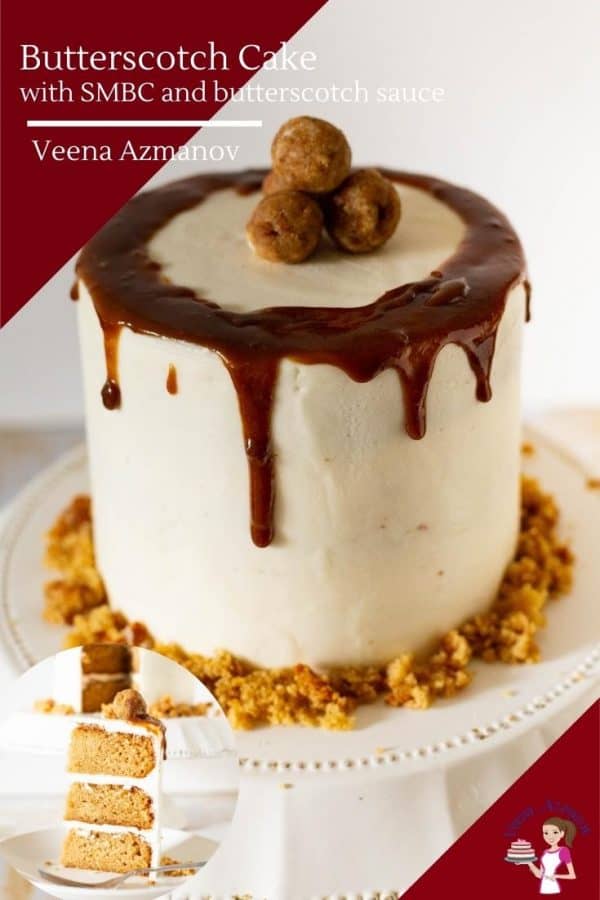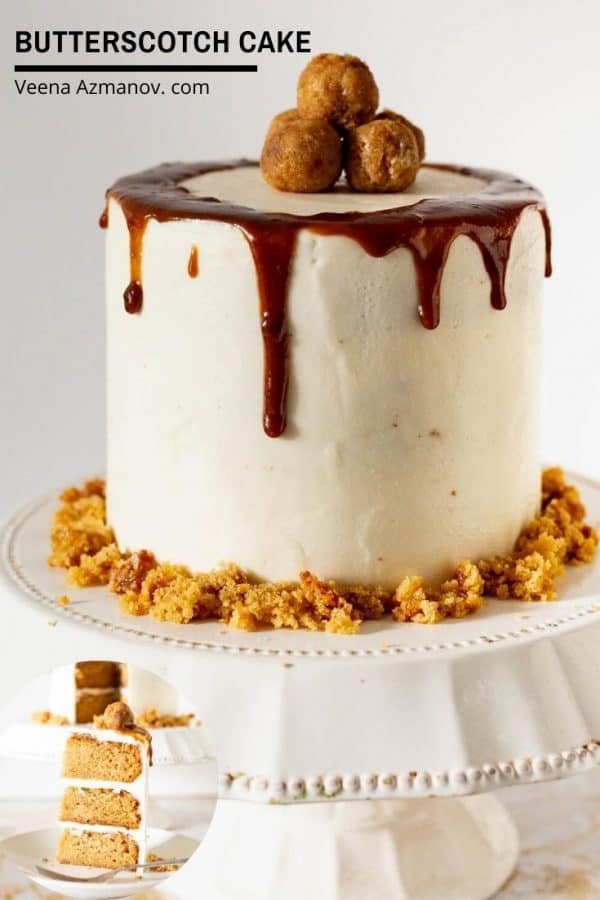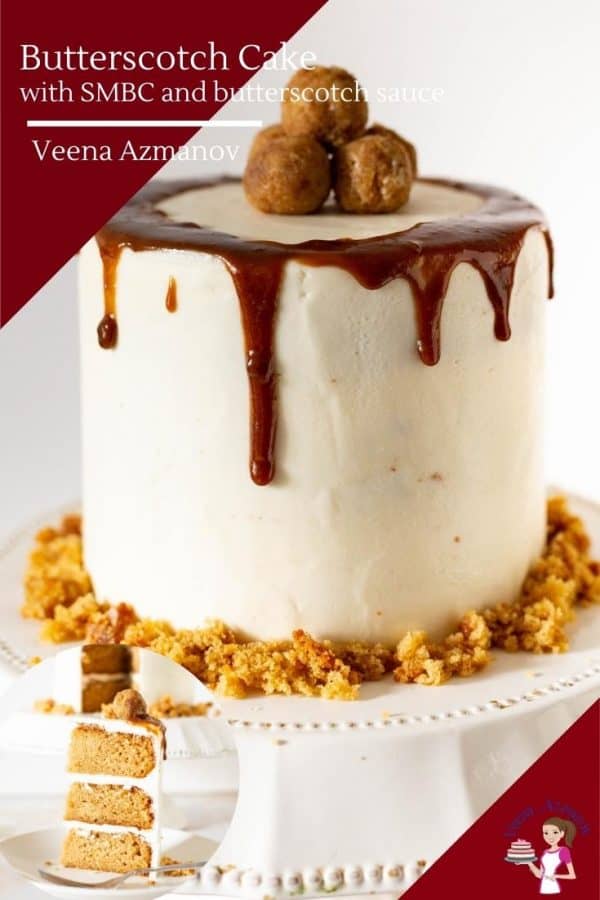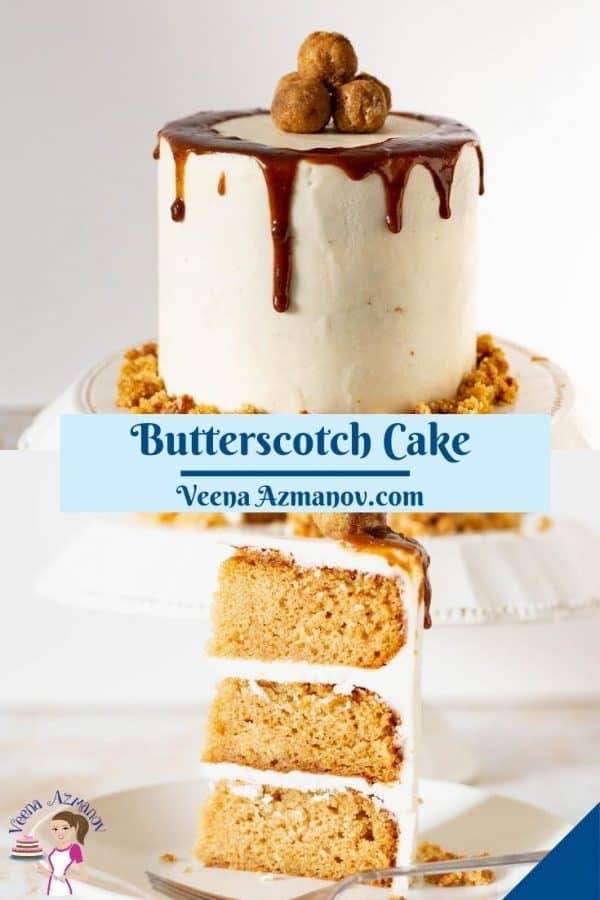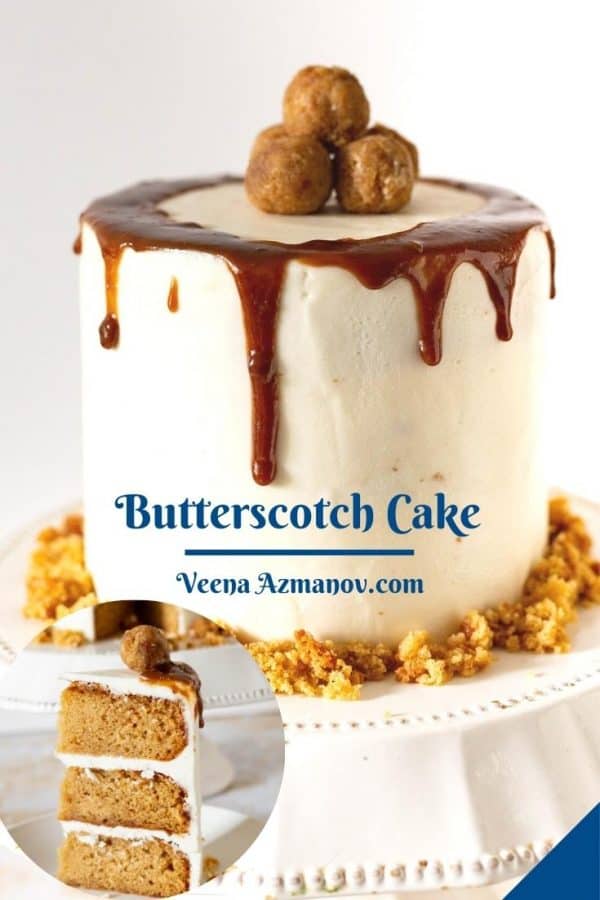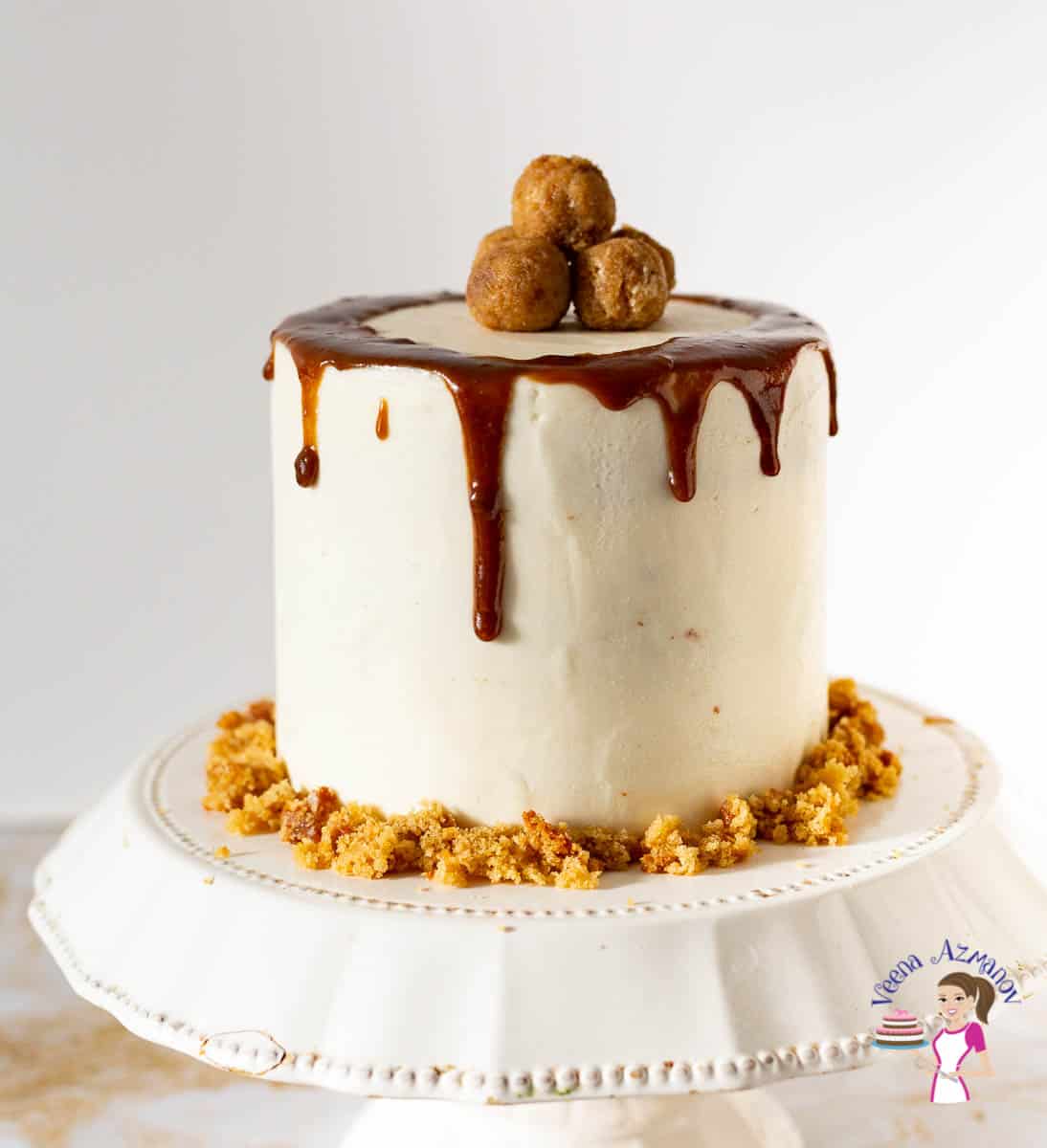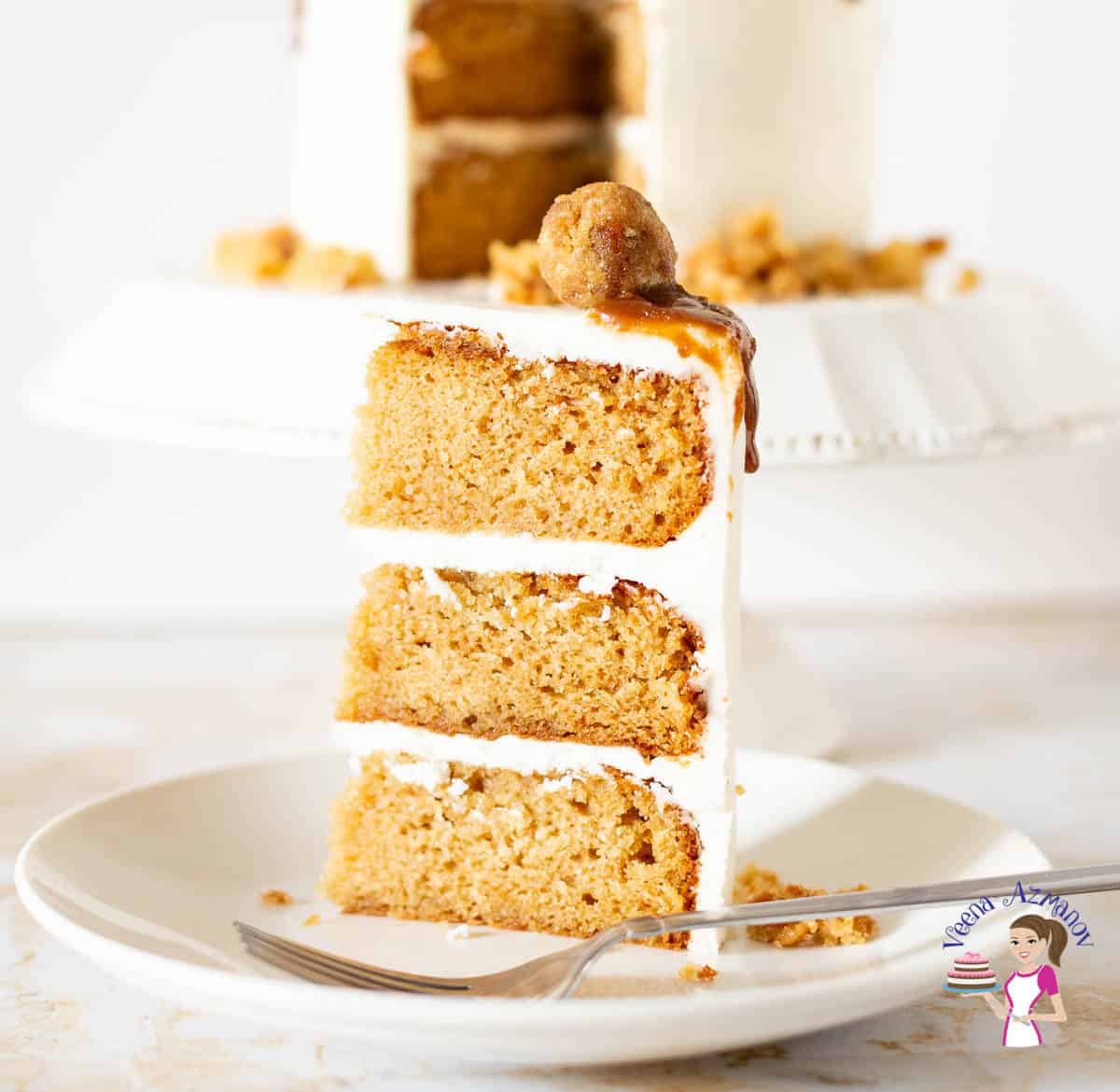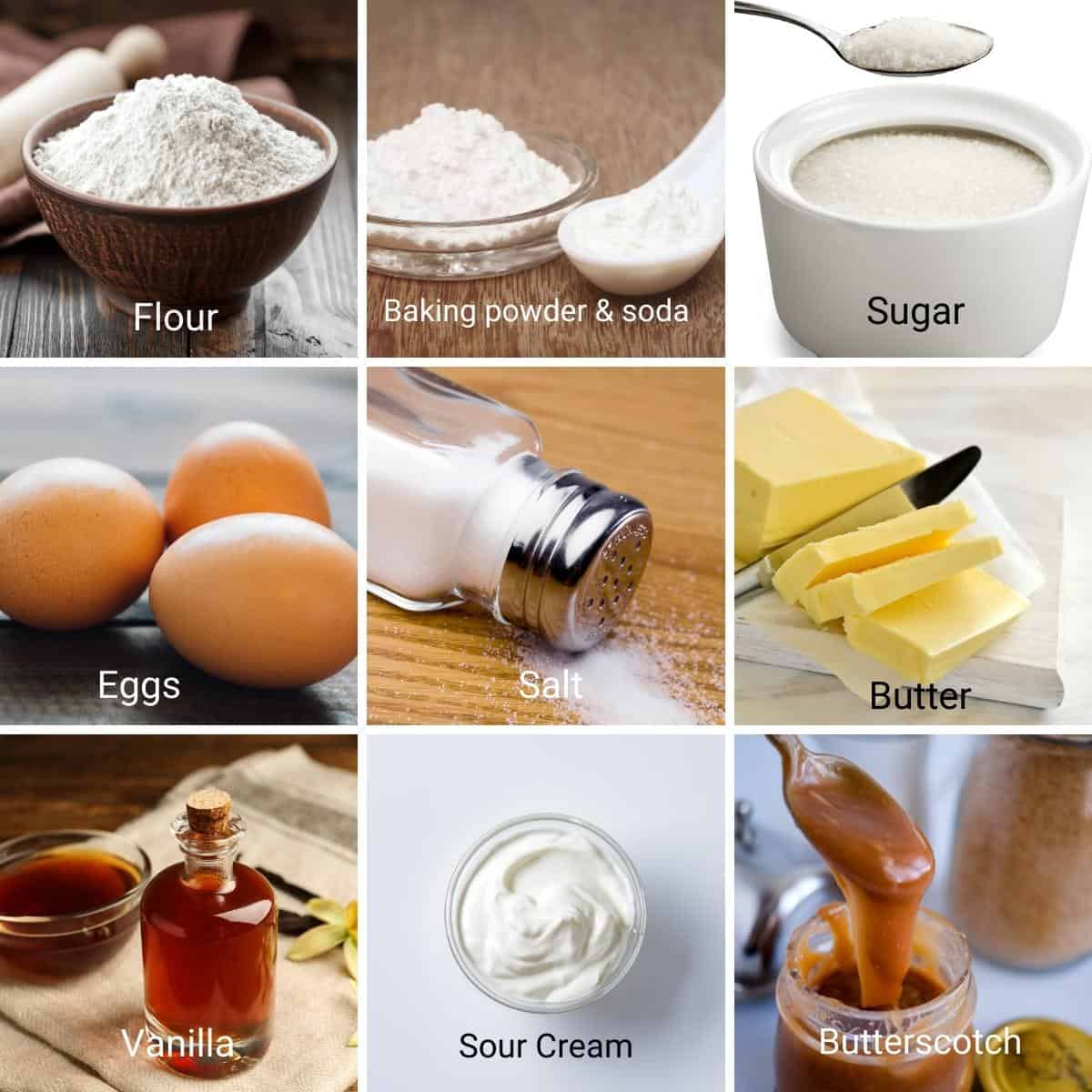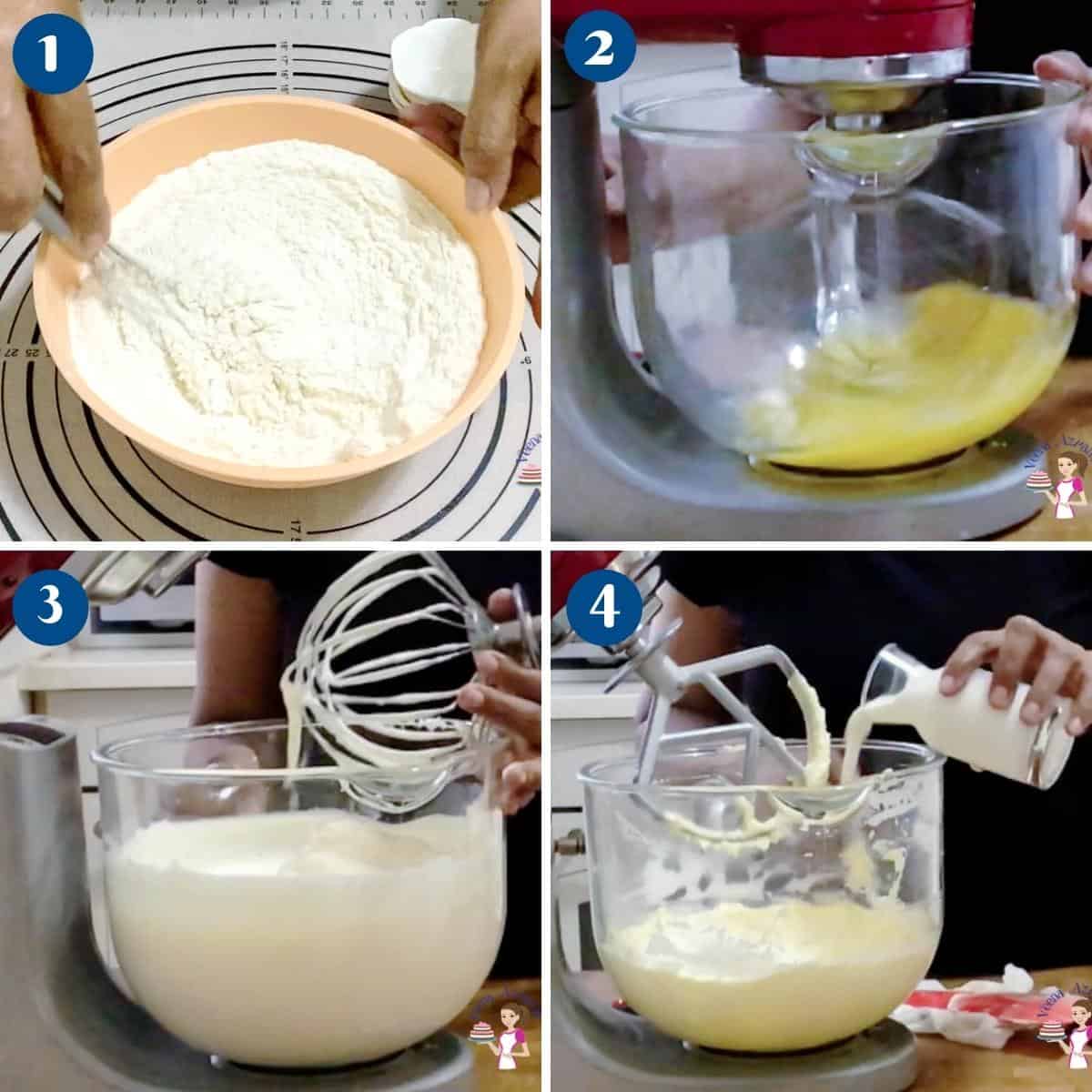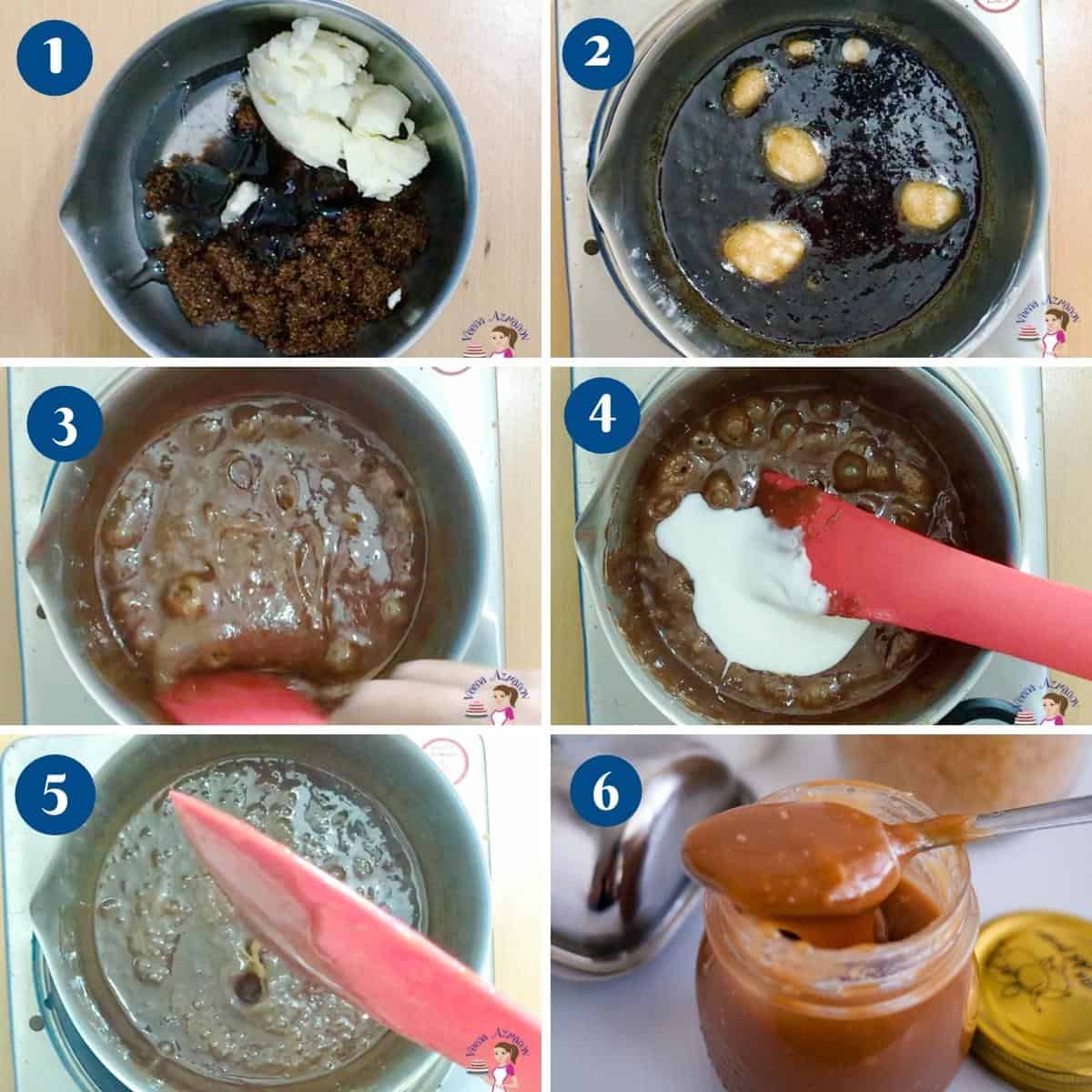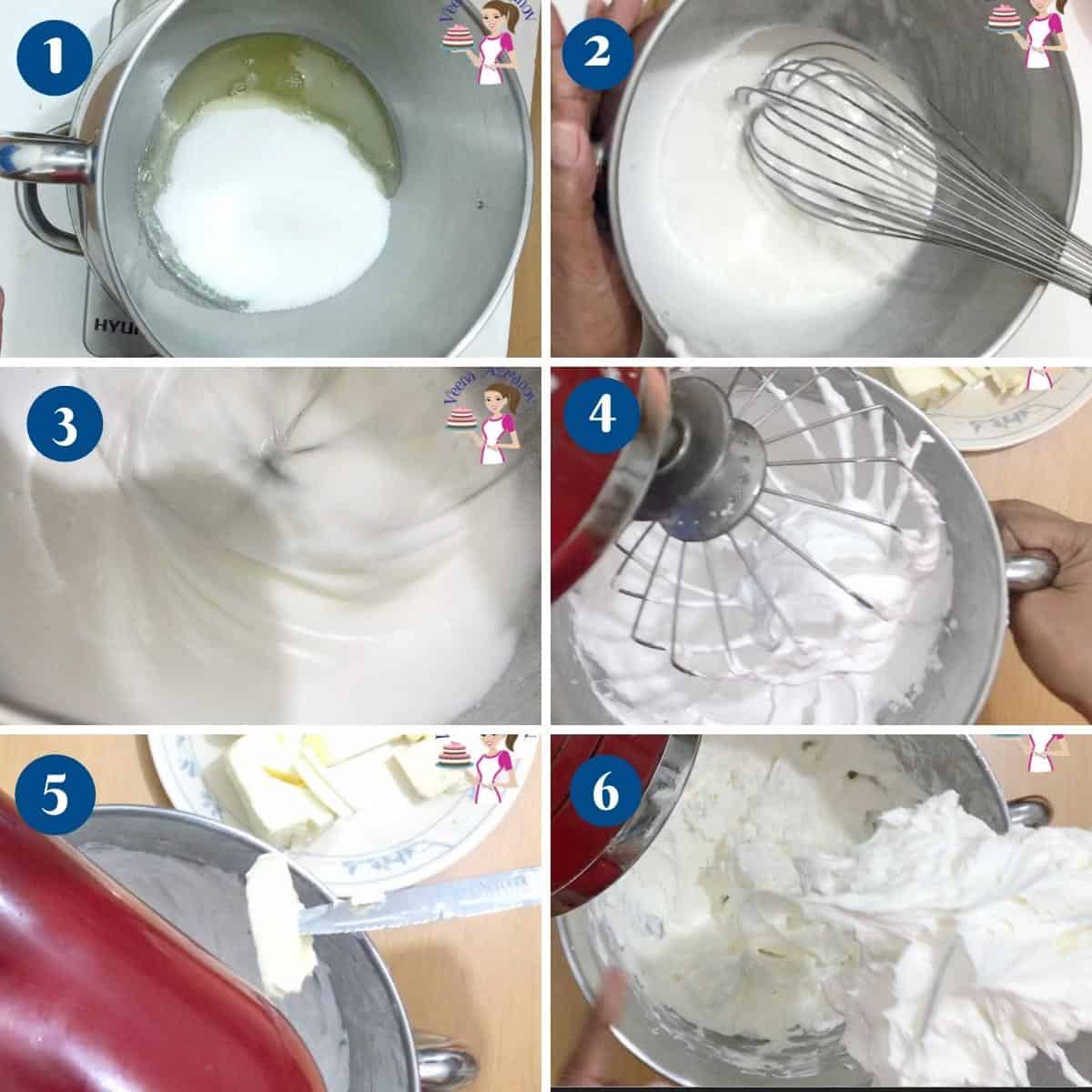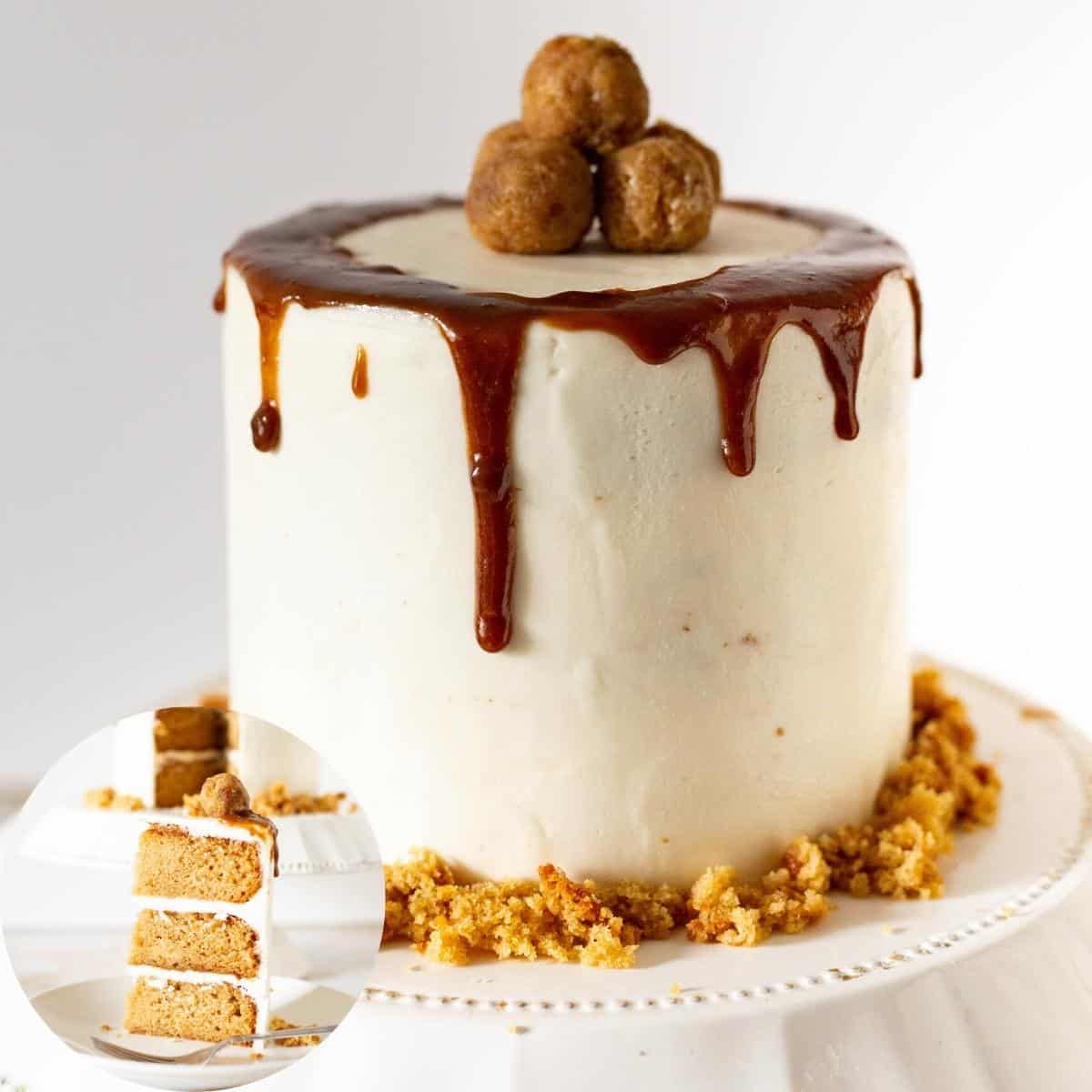I must admit I love butterscotch more than I love caramel. Often, people think butterscotch and caramel are the same, and I passionately tell them they’re not the same. Well, Butterscotch is defined by the distinct brown sugar flavor that comes from molasses. When caramelized, this gives a different flavor, aroma, and taste from regular caramel. In our home, we often make wonderful treats with butterscotch sauce, from simply drizzling it over an ice cream to making other treats like my butterscotch cupcakes, fruitcake, chocolate pecan squares, buttercream, butterscotch Irish cream, and Valentines cake for two.
Why make this cake?
This recipe is simple and easy. It makes either one 3-layer 7-inch cake or two layers of 8-inch cake. It is a butter-based recipe with whipped eggs, which gives us a moist yet light and airy cake. It is a perfect cake to make for anyone who loves butterscotch. There are three components to making this cake: Cake layers – This a version of my light and fluffy vanilla cake with butter, whipped eggs, and butterscotch sauce in the recipe The sauce – You can use store-bought butterscotch, but homemade butterscotch is so easy and takes less than 10 minutes to make. If you decide to use my homemade recipe and video, I recommend making it ahead so it has enough time to cool. Frosting – Today, I am using Swiss meringue buttercream (SMBC), but you can also use butterscotch buttercream. Of course, other buttercreams would work just as well. See my 50-plus buttercream frosting recipes on this blog.
The process and timeline for making this cake.
Prepare butterscotch sauce – 10 mins. Bake the cake – 45 minutes. Chill cake – 4 hours at least (preferably overnight). Prepare buttercream – 15 minutes. Frost the cake – 60 mins. Decorate the cake – 10 mins.
Ingredients and substitutes
Butterscotch sauce—It sounds surprising, but guess what? A butterscotch sauce works best to give this cake that butterscotch flavor. I like it better than butterscotch extract! All-purpose flour—Regular all-purpose flour works just fine in this recipe. You can use cake flour, but you will need an additional two tablespoons. Eggs – use fresh large eggs – large eggs are about 60 grams each. Dark brown sugar—This not only adds that nice butterscotch color but also flavor. If you don’t have dark brown sugar, you can use light brown sugar. If you still don’t have light brown sugar, the easiest trick is to use white sugar with molasses. For every one cup of white sugar, add 1 tbsp molasses. Sour Cream – This adds richness to the cake and keeps it moist with a tender crumb. You can make your own homemade sour cream, and Plain yogurt is also a good substitute for sour cream.
Butterscotch Cake
Cake
Grease and line 3 x 7-inch or 2 x 8- inch round cake pans Preheat the oven to 325°F / 165°C / Gas Mark 3 In a mixing bowl, combine the flour, baking powder, baking soda, and salt. Set aside. In the bowl of a stand mixer with a whisk attachment, whip the eggs until light and fluffy. Remove and set aside.Pro tip – You can also whip the eggs after you prepare the basic batter. This method does not require washing the mixer bowl in between, but you must work quickly. Next, working quickly, cream the butter and sugar until light and fluffy, about 2 minutes. Then, combine the vanilla extract, sour cream, and butterscotch sauce.Pro tip – The butterscotch sauce gives the cake its flavor. But the color comes from the dark brown sugar.
Next, add the flour mixture and combine well, but do not overmix.Pro tip – We do not want to activate the gluten in the batter, so mix until just combined. Finally, fold the whipped eggs into the batter.Pro tip – First, combine 1/3 of the egg with a whisk to prevent lumps. Then, fold the rest in with a spatula using the folding method. Divide batter equally between the prepared baking pans.Pro tip – I like to use cake strips to ensure my layer cakes bake flat. You can also use a measuring cup or weighing scale to ensure you have equal amounts. Bake on the center rack for 25 to 30 minutes or until a skewer inserted in the center comes out clean. Let cool in the baking pan for 5 minutes. Invert and cool completely on a wire rack before decorating.Pro tip – It is essential that the cakes are completely cooled before frosting. Otherwise, the frosting will melt on the warm cakes.
Butterscotch sauce
I shared how to make the butterscotch sauce in this video. Place the cream in a microwave-safe bowl – heat it for 30 secs and set aside.Pro tip – Heating the cream for a while will help blend it better with the caramelized sugar. In a heavy-based saucepan, on medium-low heat, melt butter gradually. Then, add the brown sugar, salt, corn syrup, and lemon juice. Stir continuously until melted, making sure to keep the heat on low.Pro tip – brown sugar is quite sandy when melted. So it is difficult to know if it is melted. It must look like almost a paste. Gradually add the warm cream, stirring continuously. Remove from heat and cool to room temperature.
Swiss meringue buttercream
I shared how to make Swiss meringue buttercream in this video. Place egg whites and sugar in the bowl of the stand mixer.Pro tip – Make sure the bowl is grease-free; otherwise, the egg whites will not whip. Place the bowl over a double boiler using a whisk and constantly whip until all the sugar has dissolved and the egg whites are fairly warm (about 160 F).Pro tip – You don’t need a thermometer; as long as all the sugar has completely melted, your eggs are ready to use. Take the bowl off the heat and whip the egg whites until you have a thick meringue with stiff peaks.Pro tip – It is best to start whipping eggs at medium speed, then increase speed as you go for the best meringue. Let the mixer continue to whip on medium-low until the bowl feels cool to the touch. Then, gradually add butter, one cube at a time, with the mixer at medium speed.Pro tip – It is very important that the meringue is cooled completely before you add the butter; otherwise, it will be a soupy mess. Once all the butter is added, whip on medium-high for 2 minutes. Lastly, add the vanilla. Combine well until everything is well combined.
Assemble
Prepare simple syrup – cool completely before using.Pro tip – Simple syrup is just sugar and water boiled for 3 minutes. It keeps the cake layers moist. Once cooled, cut the domes off the cake layers using a serrated knife. Save the domes for the cake balls for the top of the cake. Brush each layer with the cooled, simple syrup. Place a cake layer on the cake board or cake stand.Pro tip – If you plan to move the cake again, it is best to use a cake circle under the cake, so you can pick it up with its base and without any accidents. Top with a big dollop of the frosting—spread evenly with an offset spatula or spoon. Then, top with the second cake layer, followed by more buttercream, then the top layer.Pro tip – It is best to lift individual cake layers on pieces of clean cardboard or cake lifter so you do not break them from table to cake. Place the cake in the fridge to chill for 10 to 15 minutes.Pro tip – Chilling the cake at this point will ensure the layers don’t move when you frost the outside. However, if you leave the cake uncovered in the fridge for too long, it can dry out. So, 10 minutes is all you need. Crumb coat – Spread more buttercream around and on top of the cake. (see video). Chill the cake for another 15 to 30 minutes.Pro tip – Chilling the crumb-coated cake will ensure no cake crumbs get into the rest of the buttercream, and you will have a nice, clean cake. Spread the remaining buttercream around and on top of the cake.Pro tip – A straight-edge spatula for the top, an offset spatula, and a bench scraper for the sides work better. Final smoothing – Dip an offset spatula and bench scraper in warm water and smooth the sides and top of the cake. Use the cooled but still pouring consistency butterscotch sauce as a drip on the cake.Pro tip – If the sauce is set, heat it in the microwave for 10 seconds or more until it is a pouring consistency.
Butterscotch balls (optional)
Place the cake domes in a bowl and break them apart into crumbs. Alternatively, you can also place the domes in the food processor and pulse to breadcrumb consistency. Add just enough buttercream and butterscotch sauce to create a dough-like consistency. Rolled the cake pop mixture into balls. Place them in the fridge for at least 15 minutes. When chilled, place them on the cake tops. Place any remaining crumbs around the cake.
More recipes with butterscotch
Butterscotch cupcakes Butterscotch Irish cream (Homemade Baileys) and Butterscotch Fruitcake Butterscotch Cake for two
Frequently asked questions
Did you LIKE this recipe? Save it for later. You can find my recipes on Pinterest. Follow me on Facebook, Twitter, and Instagram.Subscribe, and I’ll send you new recipes right to your inbox. Thank you for sharing - Save for later
